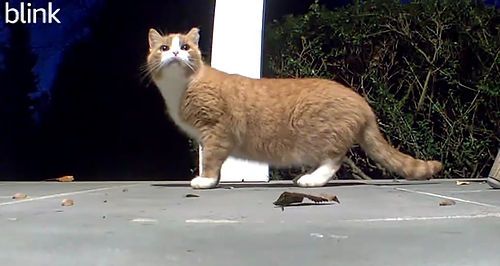Dedicated to reducing the outdoor cat population through Trap-Neuter-Return since 2000

I see cats where I live or work! Now what?
It's very concerning to see cats pop up at your home or workplace. Whether it's a cat sitting at your door, hiding under cars at work, or like this guy, showing up on your security camera during the wee hours, you know something must be done. Here's where to start if you're not the feeder.
1. Have you an ear tip?
FIrst take a good look at your visitor. If his or her left ear is clipped straight across, the cat has been fixed and either had or still has a feeder. An ear tip is a sign that someone is conducting TNR in the area, but it doesn't mean that they caught every cat or kept up with any newcomers to the neighborhood.
A great way to do this is through cameras. Set up WiFi cameras such as Blink or Ring and they will be triggered when the cats show up, when you can look for ear tips without frightening them away.
Here is Timmy, demonstrating a typical ear tip.

2. Know your ordinances
Find out the policies regarding stray and feral cats in the municipality in which the cats are located. The following questions need to be answered:
-
Does the town offer a TNR program or any kind of service for implementing TNR, such as vouchers or appointments?
-
Does the town have license requirements for cats? This does not prevent you from doing TNR, but it means that the town will likely not support your efforts if you cannot get feeders to cooperate or a landlord to allow you on the property. Whiskers has conducted TNR in many municipalities with "leash laws" and cat licensing requirements. These are short-sighted forms of legislature that do not result in fewer cats.
Do you need help finding your town's ordinances or parties responsible for animal control? We can point you in the right direction. Email us with your request.
3. Detective work

If cats are showing up, there is someone nearby feeding. Whether it is roaming males, who will travel miles to find mates, or females, who do not travel as far, they have a feeder in the area and have been allowed to reproduce if they are not ear tipped. While many of our friends here at Whiskers often hope that the cats are strays that were fixed and dumped, we come across fixed cats during TNR operations less than one time per 600 cats per year. Assume that an untipped at is an unfixed cat and set out to get them fixed ASAP!
Also, once people are feeding, they often assume they are the only feeder, despite the fact that the cats do not show up every day. If cats are not showing up daily, there is another feeder!
Unfortunately, if you are not the primary feeder and do not know the other feeders, your success will be extremely limited and trapping will be near impossible if you do not find the cats' food source. The person feeding controls where the cats go, and your bait will not be taken if there is food sitting on a porch even a half mile away!
Many people are hesitant or refuse to do this step, but it is absolutely vital. If you need help with some conversation starters, reach out to us!
At Work
Talk to the other companies in the building. You'd be surprised at how many people know exactly who is feeding, just ask! Explain that you are not looking to hurt or remove the cats, just to coordinate some spay/neuter/vetting.
At Home
Knock on doors! As a member of the neighborhood, neighbors are more likely to admit to feeding and accept help from you than they will be from an outside organization or rescue. Assure them that you are not there to harm the cats, but that they are showing up and need TNR. We have a letter template here that we and our friends have used with success. You may have to travel farther than you think--one of our friends ended up putting letters at houses four blocks away in each direction from her house, but she found three feeders and was able to get them to withhold food so that she could TNR every cat.
Other options are NextDoor and Facebook community groups, but do not give the cats' exact location for their own safety. Not everyone likes cats.
In Public Lots
Leave notes in or near the feeding bowls. You can put them in ziploc bags if the location is exposed. Learn when the person is feeding and how they are doing it. If the location does not seem safe, or you witness threats to the cats, you must involve law enforcement as feral cats are protected by the cruelty statutes of the state of New Jersey. Call the police number for the town in which you see the cats.
4. GET PERMISSION FROM THE PROPERTY OWNER!
Once you have armed yourself with information such as town ordinances and who is feeding and when, it's time to get permission from property owners to trap. If you are a renter and trapping in your apartment complex, you need the landlord's permission. If you are trapping at work, you need your supervisor's permission, as well as that of the building owner. If you do not know who owns the building, the information can be found at NJ Parcels.
Most importantly, if you are trapping in a public place, such as a park, dump, school, parking lot, or business, you must obtain the owner's permission.
If you cannot obtain the owner's permission, do not attempt to trespass and trap the cats. If your town has ordinances that support TNR, it is worth reaching out to the township to discuss the possibility of accessing the location.
If you witness sick or injured cats, the municipality's animal control is required to pick them up in accordance with state law.
If you witness threats of poison or other harm during your research, including the feeder denying medical care to the cats - you must report it to the police department and Humane Law Enforcement Officer, who is designated to respond to cruelty complaints.


